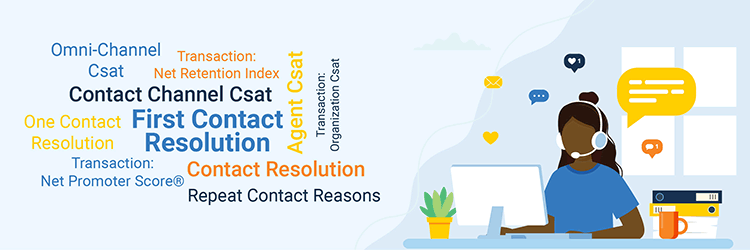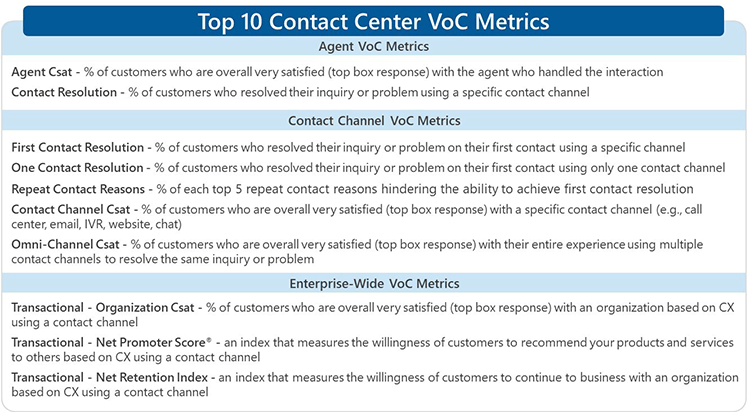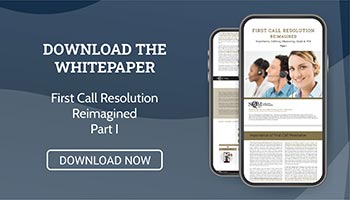Customer Expectation's Using a Contact Channel
Today's connected customers expect to effortlessly resolve their inquiry or problem on the first contact, regardless of what contact channel(s) they choose to use. In fact, in the vast majority of contact channel interactions, customers expect to resolve their inquiry or problem in one contact regardless of the contact channel they choose to use or the complexity of the inquiry or problem.
Customers' expectations to resolve any contact reason using any contact channel they choose is a big challenge for contact centers to meet. SQM research shows that 93% of customers using the call center channel and 72% of customers using the website channel expect to resolve their inquiry or problem in one contact. Furthermore, SQM's research shows that for every 1% improvement in First Contact Resolution (FCR), there is a 1% improvement in contact center customer satisfaction (Csat).

Top 10 Contact Center Customer Service Metrics to Measure
In most cases, the top 10 contact center customer service metrics apply to any industry and contact channels used by a customer to resolve an inquiry or problem. The top 10 contact center Voice of the Customer (VoC) metrics are based on post-contact customer transaction surveys. SQM's Top 10 VoC Metrics provides valuable insights into customers' experiences (CX) using a contact channel or multiple contact channels to resolve an inquiry or problem.
The following is the Top 10 Contact Center Customer Service Metrics to Measure:

Figure 1 shows the Top 10 Contact Center Customer Service Metrics definition. These metrics are split up into three main areas: Agent VoC Metrics, Contact Channel VoC Metrics, and Enterprise-Wide VoC Metrics. The agent and contact channel CX metrics are primarily used for measuring a customer's interaction experience. In contrast, the enterprise-wide CX metrics are most often used for measuring the impact that a customer's interaction has at an organization level.
Figure 1: Top 10 Contact Center Customer Service Metrics to Measure Definition

Contact Center VoC Metrics

Agent Csat
Agent Csat is defined as the percentage of customers who are overall very satisfied with the agent who handled their interaction. The benchmark average for agent Csat very satisfied (top box response) is 85%. Agent Csat metric has high buy-in from agents because they like that the metric is a VoC metric, and they have control over their Csat performance. SQM uses a 4-point satisfaction scale with "very satisfied" anchoring the highest point of the scale and "very dissatisfied" anchoring the lowest point of the scale. For Csat, SQM uses the top box response for benchmarking purposes because anything less than Csat top box response represents an opportunity for improvement.
Contact Resolution
Contact Resolution is defined as the percentage of customers who resolved their inquiry or problem using a specific contact channel. It might take two or more contacts to be resolved, but it was resolved. The benchmark average for contact resolution is 88%. The majority of organizations do not know whether or not they resolved the customer's inquiry or problem. It is assumed that if the customer does not call back, then their inquiry or problem is resolved. However, for unresolved contacts in the best-case scenario, it might be that the customer chooses to use a different channel to resolve their inquiry or problem. In the worst-case scenario, the customer may have gone to another organization. Therefore, it is essential to measure VoC contact resolution by contact channel.
First Contact Resolution
First Contact Resolution is defined as the percentage of customers who resolved their inquiry or problem on their first contact using a specific contact channel, such as a call center, web self-service, IVR self-service, email, or chat. FCR does not take into consideration whether or not other contact channels were used. The term 'contact' can be replaced with the specific contact channel (e.g., 'first call resolution, 'first email resolution', 'first web self-service resolution', or 'first IVR self-service resolution'). Many SQM clients consider First Call Resolution to be their most important CX metric for measuring and managing CX. The benchmark average for FCR is 72%. This means that nearly one-third of customers have to contact the contact center again to resolve their inquiry or problem, which, for most organizations, represents a considerable opportunity to improve.
One Contact Resolution
One Contact Resolution (OCR) is defined as the percentage of customers who resolved their inquiry or problem on their first contact using only one contact channel. In other words, not having to use another contact channel prior to, during, or after using the single contact channel. The benchmark average for OCR is 62%. When you ask customers what is most important to them when they use a contact channel – a clear majority of them will say they want to resolve their inquiry or problem on the first contact using only one contact channel. Given that customers want their inquiry or problem resolved on the first contact using one contact channel, the OCR metric is perfect for measuring whether they received that experience. An essential distinction between FCR and OCR is that FCR only considers the usage of an individual contact channel, and OCR factors in using multiple contact channels to resolve an inquiry or problem.
Repeat Contact Reasons
Repeat Contact Reasons is defined as the percentage of the top 5 repeat contact reasons hindering the ability to achieve first contact resolution. For example, the benchmark average for the top 5 repeat contact reasons represents 43% of all the repeat contact reasons. Therefore, focusing on the top 5 repeat contact reasons (e.g., agent lack of knowledge, verification of status update, request not done, redirection to a 3rd party, and not satisfied with solution) is a best practice for identifying what areas to focus on for improving FCR because they represent the main reasons why customers are having to call back the call center.
Contact Channel Csat
Contact Channel Csat is defined as the percentage of customers who are overall very satisfied with a contact channel experience. The benchmark average for contact channel Csat very satisfied (top box response) is 77%. Contact channel Csat has been the most widely used and understood CX metric of all the VoC metrics. Perhaps the popularity of Csat is due to the fact that it has been used for many years. At SQM, we recommend measuring Csat at the individual contact channel level as well as at the enterprise-wide level. SQM uses a 4-point satisfaction scale with "very satisfied" anchoring the highest point of the scale and "very dissatisfied" anchoring the lowest point of the scale. For Csat, SQM uses the top box response for benchmarking purposes because anything less than Csat top box response represents an opportunity for improvement.
Omni-Channel Csat
Omni-Channel Csat is defined as the percentage of customers who are overall very satisfied with their entire experience using multiple contact channels to resolve the same inquiry or problem. The benchmark average for omni-channel Csat very satisfied (top box response) is 55%. SQM research shows that 42% of customers use two or more contact channels simultaneously to resolve the same inquiry or problem, and 20% of customers who used a call center did so because a self-service contact channel failed. The benchmark average for seamless experience is 57%. Furthermore, the majority of North American organizations do not know how to measure CX for those customers who used two or more contact channels to resolve the same inquiry or problem. As a result, SQM is often asked, "What is the best way to measure CX for those customers who used two or more contact channels to resolve the same inquiry or problem?" We recommend using the seamless and omni-channel experience metrics.
Transactional - Organization Csat
Transactional - Organization Csat is defined as the percentage of customers who are overall very satisfied (top box response) with an organization based on CX using a contact channel. The benchmark average for organization Csat very satisfied (top box response) is 71%. For enterprise-wide VoC metrics, transaction surveys are used to understand how a customer's experience using a contact channel impacted the overall view of the organization. For transactional organization Csat metric, SQM uses a 4-point satisfaction scale with "very satisfied" anchoring the highest point of the scale and "very dissatisfied" anchoring the lowest point of the scale.
Transactional - Net Promoter Score®
Transactional - Net Promoter Score® (NPS®) is defined as an index that measures the willingness of customers to recommend your products and services to others based on CX using a contact channel. NPS is widely used by many leading North American companies and, in many cases, is the most critical metric they use for measuring CX and understanding the impact that a contact channel CX has on customers' likelihood to recommend the organization to others. The NPS® benchmark average is 41% for customers who used a contact channel. On average, contact centers' management groups manage or share ownership of six contact channels and, as a result, are responsible for CX on most, if not all, interactions a customer has with an organization. Therefore, contact centers have a significant impact on customers referring the organization to others.
Transactional - Net Retention Index
Transactional - Net Retention Index (NRI) is defined as an index that measures the willingness of customers to continue to business with an organization based on CX using a contact channel. The NRI benchmark average is 60% for customers who used a contact channel. It has long been SQM's belief that customer retention should be one of the main purposes of the contact center, especially when you consider that, in many cases, a contact center is the last line of defense to stop a customer from defecting. Customer retention means that customers are not leaving the organization as a result of their contact center experience. By retaining customers, the contact center protects the organization's greatest asset – its customers. Unresolved contacts are a leading indicator of customers defecting to competitors. 13% of calls are unresolved, and in most cases, call center employees do not know which customers call goes unresolved. What is alarming about that is when a customer's issue was unresolved, 25% of those customers said they intend not to continue using the organization's products and services.




